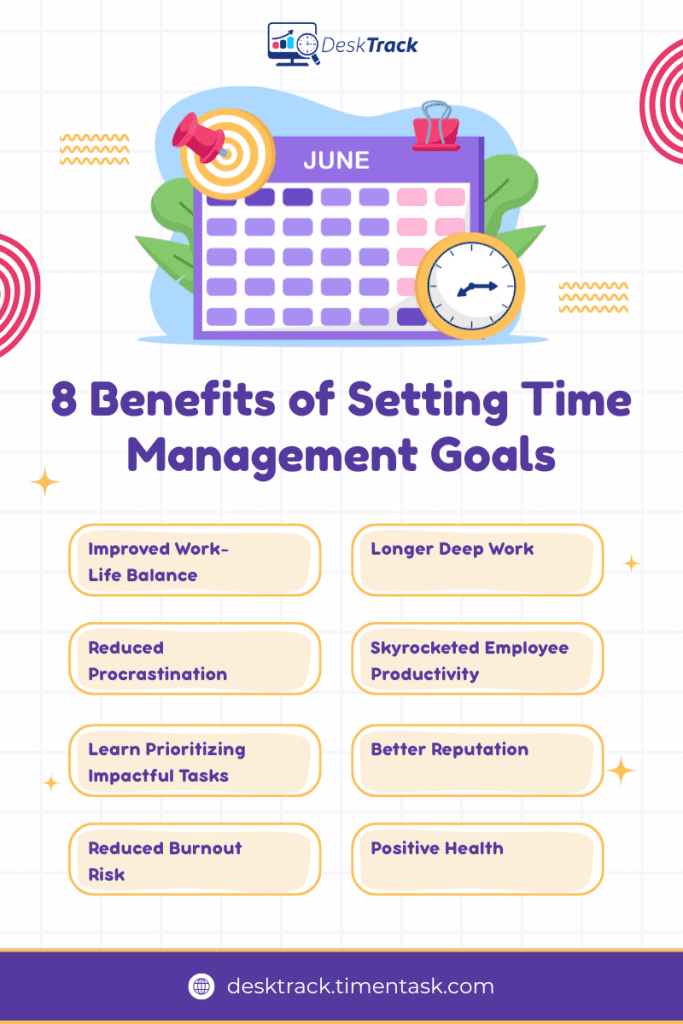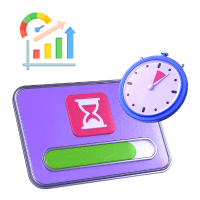
To properly manage your time or work hours, you need to set time management goals. At first, it looks simple. However, when you go to configure it, it can get frustrating. That’s right. Most human resources don’t know where or how to begin. Thus, they falter even before something good happens and then go about their work days as usual. No improvement in efficiency and nothing productive.
That’s where we come in. We will teach you and your employees to make the most out of your time, improve efficiency, reduce stress and burnout, and most importantly, improve work-life balance. You can achieve all these benefits by making just a simple and small change. When we describe the ideal qualities of time management goals, they are simple techniques that bind what you plan to achieve with how you manage your time.
So, in today’s blog, we will tell you all about the top 15 time management goals for 2025. Plus, how to set them up, how they benefit you and your employees, and all related insights. With that out of our way, let’s get started making how you manage your hours efficient.
What are Time Management Goals?
Simply put, time management objectives are transparent metrics that help you schedule and plan your work and other activities to achieve the desired outcome or beyond. These goals provide you with a clear structure for approaching not only daily tasks but also long-term expectations. They guarantee that the limited work hours are properly utilized to achieve particular results and boost efficiency.
Now, we will describe the ideal qualities of time management goals, or rather SMART goals for managing hours.
- Specific: Be transparent about what you want your staff to achieve.
- Measurable: You should be able to scale the metrics in some quantity.
- Achievable: The goal must be achievable.
- Relevant: The goal must be relevant. Especially for the ones putting in the hard work to reach it.
- Time-Bound: The objective must be achieved within a specified bracket.
Read Also: Top 10 Best Jira Alternatives for 2025
6 Steps to Create Time Management Goals that Work
Make your workday more productive
Time tracking and work management can help you reach your goals
faster.
There are many ways to create time management goals. All of them but this one fail because there is one aspect missing. That is consistency. So, here are 6 consistent steps to make work-hour management work for you.
1. Set Precise Targets
First things first. What do you want to achieve? Be precise on that and define those objectives with as much specificity as possible. For instance, it can’t be more precise than the expectation to achieve a 20% sales boost via targeting priority clients by region with promotional coupons.
2. Apply the SMART Criteria
Don’t forget to be SMART when configuring. Here, SMART expands to specific, measurable, achievable, relevant, and time-restricted. For example, the developers have 6 months to code a high-quality employee monitoring software solution that boosts employee productivity by 40%.
3. Subdivide Goals
The next thing to do when setting up your time management goals is not to set work hours in a stretch. Divide goals into small, manageable chunks known as tasks and track the time on each one individually to get more detailed and precise insights. This also makes it easy to identify where you are lagging. For instance, 10 minutes for writing an AI prompt, 2 hours to write a web page content, and 30 minutes to edit a YouTube Shorts video.
4. Keep Deadlines Realistic & Inspiring
For instance, coding a full-fledged console game within 1 or 2 workdays is the most unrealistic deadline ever, and if you are setting such deadlines, you should reconsider why you run a business. Instead, keep your deadlines SMART.
5. Prioritize Goals
It’s self-explanatory that getting the prototype approved by the client is a higher priority task than moving ahead with the development. That’s just one example of prioritizing time management goals.
6. Review & Adjust Goals Regularly
External and internal conditions, such as insider threats, technological malfunctions, and employee emergency leaves, affect the process and pace at which you want to achieve your objectives. So, it is mandatory to adjust accordingly. Also, if one way is not working, you may need to introduce a better method.
8 Benefits of Setting Time Management Goals

You must also be wondering. Why should you set time management goals? Let us give you not 1 but 8 reasons for doing so as soon as possible.
1. Improved Work-Life Balance
When everything moves smoothly and the workflow is streamlined, there is no need for unnecessary overtime. Employees can go home to their wives and kids on time each day, which improves work-life balance.
2. Reduced Procrastination
When you have your time management goals straight, there is no room for procrastination. Since you already know what comes next, as you have planned your priorities and will work accordingly, there is no room for overthinking.
3. Learn Prioritizing Impactful Tasks
Knowing how to properly manage your time also ensures that you know which tasks impact your long-term objectives. So, you will consider giving the most time to these, and of course, complete them first.
4. Reduced Burnout Risk
Another beneficial time management goal example is reduced burnout risk. For instance, if an employee is continuously working, she or he will eventually get mentally tired and frustrated, leading to burnout. When employees know how to properly manage their time, they know the right hours to take short breaks to relax, which reduces the risk of burnout to almost zero.
5. Longer Deep Work
Deep focus is a technique where you focus on a task in-depth while blocking all distractions. Simply put, you work without thinking about anything else. By properly knowing how to manage your time, you can easily work deeply for a longer time.
6. Skyrocketed Employee Productivity
Completing tasks on time, setting priorities straight, and working deeply with full concentration lead to increased work-time utilization efficiency. There is no stress, prioritization, or burnout. Thus, employee productivity is maximized.
7. Better Reputation
That’s on both personal and professional levels. This is due to time management goals mastery. People rely on the person who completes their work on time and even gets motivated by them.
8. Positive Health
Improved work-life balance, no stress, and no burnout are all indicators of positive mental health. Overall, this also leads to improved employee efficiency and productivity, as there are no other pain points we know of.
15 Strategic Time Management Goals & Techniques for Success in 2025

We not only have 1, not 2, but 15 time management goals for employees examples for you and your employees. Based on the preference and level of flexibility, you and your employees can choose the best options. However, some of these are compulsory, unless you want to experience extreme burnout.
1. Prioritize Daily Tasks
The first thing to do is set priorities for your daily tasks. Do the crucial ones first and then the rest. Some of these tasks can even be dropped or delegated if they are consuming too much of your time.
2. Limit Social Media
Did you know that approximately 77% of employees agree to using social media at work? That’s 77 out of 100 distracted employees. That’s not good for you and your organization. So, one of the time management smart goals examples says that you should use social media to a bare minimum.
3. Use Visual Management
The indication here is straight to project and task management software solutions that provide you with a visual representation of your time with timelines, Gantt charts, and other elements. Trust us, managing time this way is much simpler and easier.
4. Overcome Procrastination
This one is easier said than done. However, some proven methods to overcome procrastination include:
- Mindfulness
- Yoga and meditation
- Not looking at the clock from time to time
- Deep focus
5. Take Breaks
Did you know that staff who take more frequent breaks are 13% more productive than those who don’t? So, now you know what to encourage your employees to do.
6. Delegate
Let’s face it. If you were able to do everything yourself, then you wouldn’t need your employees. Right? Task delegation must be hierarchical. For instance, you distribute tasks to your managers, and your managers further delegate to the team members. Thus, everyone has a balanced share of the workload. That’s how time management goals work in real life.
7. Have a Morning Routine
Even if it is a weekend, you must stick to a morning routine. If mornings are good, then the rest of the day is productive. For example, have a positive start to your day with a cup of coffee, a bar of chocolate, and some stretching.
8. Set Fixed Work Hours
These are fixed for you and your employees alike. For example, 9:00 to 6:30. You neither call your employees before or after this time slot, nor do you receive any work calls.
9. Regularly Review Goals
As we mentioned before, you also need to regularly review your time management objectives to align them with your current situation. This ensures that the objectives are met without employees going into work-rush mode.
10. Say No
If you are preoccupied with some other work or are not skilled enough for something, simply say no. It’s much better than unnecessarily increasing your workload and the frustration that comes with it.
11. Time Blocking
This time management technique works like the name suggests. You assign time blocks to every task and complete the particular tasks for a time slot only. This boosts focus and minimizes distractions.
12. Pomodoro
Pomodoro in Italian means tomato. Facts aside, this is one of the ace time management goals examples for freelancers. How it works is that you set a 25-minute timer during which you will only work. After that, you must take a 5-minute break. The best part is that you can repeat this cycle as many times as you like and even increase the break time after a few work sprints.
13. Limit Meeting Times
Meetings are great. They always solve the problems. However, they can also consume so much time, especially when some employees are always there with their doubts. However, there is a way to limit meeting hours. That is, for the meeting to only include the relevant things. Plus, you can also try to ensure that there are fewer meetings each week.
14. Track Time
The ace way is to use time tracking software. It’s a digital tool that automatically tracks the hours your employees spend on specific activities. Plus, it also provides you with detailed insights that let you identify work gaps, skill gaps, delays, and other obstacles in real-time.
15. Batch Similar Tasks
Batching similar tasks together makes your work much simpler. For example, putting making an ad campaign and creating the content for it into the same time block makes more sense. Right?
Read Also: Top 10 Best Time Clocks for Small Businesses in 2025
Top 5 Time Management Goals Trends for 2025

Being aware of what’s going on in the world of time management goals is also essential for you to implement techniques that can adapt to these requirements. Here are 5 patterns you need to look out for.
1. Habit Tracking
People these days use habit tracking applications to track their time management habits. That is how long they got distracted, the time spent on bad habits, etc.
2. Manage Time by Not Managing Time
This may sound weird, but let us explain. Sometimes, implementing a method to manage work hours can get overwhelming, which is not a good sign. Instead, simply do your work without stressing out too much. Time, as we all know, doesn’t stop for anyone, so go with what suits your working style.
3. Stress-Free Time Management
Manage time, but don’t overdo it with one method. You might make mistakes. However, as long as you are not missing crucial details, you are good to go. An expert tip is to keep switching techniques as per the demands of the tasks.
4. Mix & Match
If one method alone is not doing you any good, then try mixing and matching two or more. For instance, time blocking first and then, within the blocks, you go Pomodoro. This is perfect for developers who are multitasking.
5. No Clocks
If you, for instance, wear a wrist watch to work, then you will periodically keep looking at it, which will diminish your productivity. Another thing to do is not to look at the system clock again and again. Instead, implement deep focus to effectively manage your time.
Why is DeskTrack the Best Time Management Software?
DeskTrack is the complete employee monitoring and management software solution for small, medium, and large enterprises, and every professional that comes in between. With its plethora of features for field, in-office, hybrid, and remote teams and employees, nothing can stop you from maximizing productivity:
1. Screenshot Monitoring
Customize the intervals during which DeskTrack will take screenshots of employee desktops. Perfect for identifying insider threats, obstacles, and streamlining the workflow.
2. Time Tracking with Data Analytics
Automatically track and report the time spent on various tasks, activities, apps, URLs, and files in real-time.
However, DeskTrack also offers brilliant project management and data leak protection features, among others. It is the complete software to maintain work integrity.
Frequently Asked Questions (FAQ)
Q. What are Time Management Goals?
Ans. Simply put, time management objectives are transparent metrics that help you schedule and plan your work and other activities to achieve the desired outcome or beyond. These goals provide you with a clear structure for approaching not only daily tasks but also long-term expectations.
Q. What are the Benefits of Setting Time Management Objectives?
Ans. Here are the changes that you and your employees will experience.
- Improved Work-Life Balance
- Reduced Procrastination
- Learn Prioritizing Impactful Tasks
- Reduced Burnout Risk
- Longer Deep Work
- Skyrocketed Employee Productivity
- Better Reputation
- Positive Health
Q. How to Set the Goals for Effectively Managing Time?
Ans. You will need these 6 steps.
- Set Precise Targets
- Apply the SMART Criteria
- Subdivide Goals
- Keep Deadlines Realistic & Inspiring
- Prioritize Goals
- Review & Adjust Goals Regularly
Q. Which are the Best Time Management Techniques?
Ans. Here are 15 of them.
- Prioritize Daily Tasks
- Limit Social Media
- Use Visual Management
- Overcome Procrastination
- Take Breaks
- Delegate
- Have a Morning Routine
- Set Fixed Work Hours
- Regularly Review Goals
- Say No
- Time Blocking
- Pomodoro
- Limit Meeting Times
- Track Time
- Batch Similar Tasks
Q. Will You Recommend Any Tips to Effectively Manage Time?
Ans. Certainly. By time blocking interruptions such as emails and deep focusing once daily, you will eliminate distractions, streamline the workflows, and improve your work-time utilization efficiency level.








